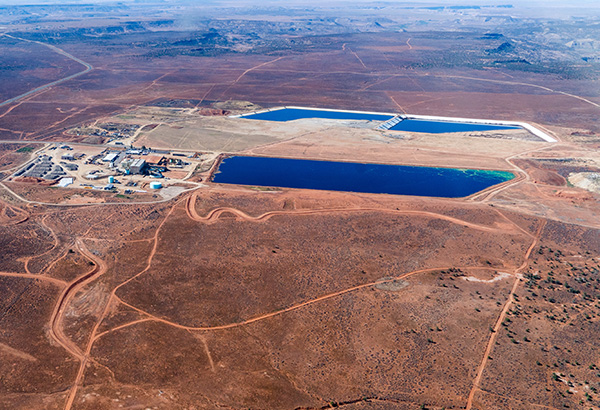FOR IMMEDIATE RELEASE
WHITE MESA, UTAH — A July 7, 2022 EcoFlight overflight of the White Mesa Mill in southeastern Utah, near the Ute Mountain Ute community of White Mesa and a mile from Bears Ears National Monument, has revealed new changes to a massive radioactive pit at the controversial uranium mill.


LEFT: Cell 1 on July 7, 2022. RIGHT: Cell 4B (bottom left corner) on July 7, 2022. TIM PETERSON, FLOWN BY ECOFLIGHT
By law, solid materials in holding and processing ponds at the mill are required to be covered in liquid, which acts as a barrier to cancer-causing radon gas emitted by the material in the ponds.
Aerial photos showed a bright green substance in the southwest corner of a 55-acre pond known as "Cell 1" that did not appear to be covered in liquid. The issue with Cell 1 arises at the same time that the mill is working to fill another pond with liquid — 40-acre "Cell 4B" — after the Environmental Protection Agency (EPA) issued an order to mitigate radon emissions. Despite this directive, a large area of solid material remained visible in Cell 4B more than seven months later.
"The observation on Cell 1 is concerning," said Scott Clow, environmental programs director for the Ute Mountain Ute Tribe. "With 40 years of accumulated materials in there, having them exposed may be very hazardous. Energy Fuels is aware of what the NESHAPS Subpart W regulations require, and they participated in the rulemaking process, starting with the first meeting I attended with them and the Utah Division of Air Quality. They need to comply with it."
In December 2021, the EPA barred the White Mesa Mill from accepting more radioactive waste from highly contaminated "Superfund" sites, estimating that uncovered waste in Cell 4B was emitting nearly 10 times more radon than waste covered in liquid.
After a request for reconsideration from the mill's owner, on July 18, 2022, the EPA modified its original order to allow the mill to accept Superfund waste as long as the remnants of that waste are not discarded in Cell 4B, pending inspection. The EPA will perform on-site inspections in the coming weeks.
"We should not be playing whack-a-mole when it comes to managing radioactive material,” said Grand Canyon Trust Staff Attorney Chaitna Sinha. "The mill has still not complied with the law on Cell 4B, and now there are signs that the mill may be out of compliance with the law when it comes to Cell 1. We hope the EPA will carefully inspect Cell 1 and take into consideration the photographic evidence documenting the changes in Cell 1 obtained during the July 7 overflight. Cell 1 is subject to the same rules as Cell 4B and must be covered in liquid to reduce emissions of cancer-causing radon."
Originally designed and built to process natural uranium ore, the mill has transformed its business model to operate as a waste-disposal service, earning millions in fees to process and discard over 700 million pounds of radioactive wastes from industrial and military facilities. The Ute Mountain Ute Tribe is concerned about severe health impacts on tribal residents in White Mesa and has urged the mill to close.
READ THE REPORT: The Business of Radioactive Waste: a high-stakes game of hot potato ›
"Superfund waste comes from the nation’s most contaminated sites," said Grand Canyon Trust Cultural Landscapes Director Tim Peterson. "It appears the mill may have slipped from one tailings cell in violation to two. That’s unacceptable; the mill should never be allowed to accept Superfund waste."
"EcoFlight will continue to fly and watchdog the White Mesa uranium mill with the Ute Mountain Ute Tribe and Grand Canyon Trust to ensure that Energy Fuels upholds the tenets of community health and quality of life for all in the White Mesa/Bears Ears area while operating their mill," said Jane Pargiter, executive director of EcoFlight.
Photos and video
Photos (free for media use) ›
High resolution photos ›
Video of an April 5, 2022 overflight ›
Video of the July 7, 2002 overflight ›


